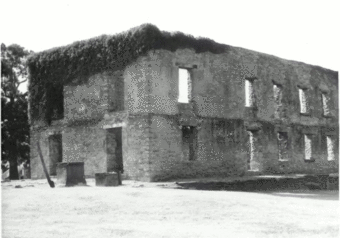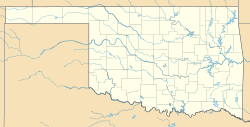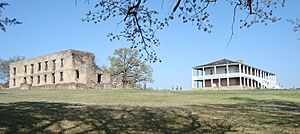Fort Washita facts for kids
|
Fort Washita
|
|

West barracks in 1975
|
|
| Location | Bryan County, Oklahoma |
|---|---|
| Nearest city | Durant, Oklahoma |
| Built | 1841 |
| NRHP reference No. | 66000626 |
Quick facts for kids Significant dates |
|
| Added to NRHP | October 15, 1966 |
| Designated NHLD | June 23, 1965 |
Fort Washita is an old United States army base in Oklahoma. It's located near Durant, Oklahoma, on Highway 199. General Zachary Taylor, who later became president, started the fort in 1842. Its main job was to protect the Choctaw and Chickasaw people. These Native American nations had moved to this area. The fort kept them safe from other groups like the Plains Indians.
When the American Civil War began, the U.S. Army left the fort. Confederate soldiers then took over. They stayed until the war ended, burning the buildings before they left. The U.S. military never used Fort Washita again.
Years later, the Oklahoma Historical Society bought the land in 1962. They worked to restore the old fort. In 2017, the Chickasaw Nation bought Fort Washita. They now manage the site. Today, Fort Washita is a popular place for visitors. It hosts many events throughout the year. In August 2023, the U.S. government took over the trust of the Fort Washita Historic Site.
Contents
Where is Fort Washita Located?
Fort Washita is about 12 miles (19 km) northwest of Durant, Oklahoma. It sits on Oklahoma State Highway 199. The fort is just north of where the Washita River meets the Red River. The original fort was very large, covering over seven square miles. It had more than ninety buildings and sites.
A Look Back: Fort Washita's History
Native American Nations Move West
In the 1830s, the U.S. government wanted land in the southern states. They passed the Indian Removal Act in 1830. This law forced many Native American nations to move west. The Choctaw people were among the first to move. They signed a treaty in 1830. This gave their lands in Mississippi and Alabama to the U.S. They moved to a new area called the Indian Territory. This territory is now part of Oklahoma.
The Choctaws settled in the southern part of the Indian Territory. This area bordered the Red River. A natural barrier of thick trees, called the Cross Timbers, separated them. This barrier helped protect them from Plains Indians to the west. But sometimes, groups like the Comanche and Kiowa would raid their settlements. Federal troops at Fort Towson helped protect the eastern Choctaw lands.
Early Explorations and the Chickasaw Nation
In 1834, the U.S. Army explored the area. They set up a temporary camp called Camp Washita. This camp was near the mouth of the Washita River. It helped them operate in the region. Roads were built to connect it to other forts. But Camp Washita was closed later that same year.
The Chickasaw people moved to the Indian Territory in 1837. They bought land from the Choctaws. However, the Chickasaws were worried about settling in their new area. It was not safe from the Plains Indians. Fort Towson was too far away to protect them. So, in 1838, officials asked the army to build a new fort. This fort would be near the Washita River. It would help keep the Chickasaws safe.
Building a New Fort
The U.S. Army agreed to build a new fort. It would be on Choctaw land, west of Fort Towson. General Zachary Taylor chose the spot for Fort Washita in 1842. He picked a high piece of land. It was about 1.5 miles (2.4 km) east of the Washita River. It was also 18 miles (29 km) north of the Red River. At that time, the Red River was the border with the new Republic of Texas.
Fort Washita was in a very important spot. It was near two rivers. An old trail, called the Texas Road, also ran through the area. This trail went from Missouri to Texas. Fort Washita became a major stop on this road. Later, the Shawnee Cattle Trail used this route. Just before the Civil War, the Butterfield Overland Stage also passed nearby.
The fort was connected to other forts by military roads. These roads linked Fort Washita to Fort Towson and Fort Gibson. Later, roads also connected it to Fort Arbuckle and Fort Sill.
Construction of Fort Washita started in the spring of 1842. Soldiers built temporary log barracks first. Getting supplies was hard because the fort was so far away. Most building materials came from the local area. Some supplies were shipped from Fort Towson.
In 1843, the army almost decided to close Fort Washita. But General Taylor explained how important its location was. So, the War Department approved keeping the fort open. The U.S. Army officially took over the post on April 23, 1843.
The Mexican–American War and Gold Rush
When the Mexican–American War started in May 1846, Fort Washita became very busy. It was a key place for soldiers to gather before heading to war. Many troops passed through the fort. During the war, the number of soldiers at the fort grew from 150 to almost 2,000. The war ended in 1848.
After the war, the Chickasaws created their own government. They needed more protection from the Plains Indians. The fort continued to provide this safety. In 1849, the temporary log barracks were replaced. New barracks were built from strong limestone.
After gold was found in California in 1848, many people traveled west. They often chose a southern route to avoid cold winters. Fort Washita became a meeting point for these travelers. They would gather in large groups for safety. In 1850, another fort, Fort Arbuckle, was built further west. This helped protect the California travelers even more.
Fort Washita's importance changed over time. As more people settled, the frontier moved west. New forts were built further out. By 1858, the fort had stone barracks, a hospital, and other buildings. It also had stables for cavalry. For a while, it even served as an artillery school. In 1858, the fort closed temporarily. This was because its troops were sent to Utah for the Utah War. But it reopened later that year due to increased Comanche activity.
The Civil War and What Happened Next
Federal troops were still at Fort Washita when the Civil War began in April 1861. Colonel William Emory gathered all his troops at Fort Washita. When he heard about the war, he led his forces north to Kansas. Confederate forces then took control of Fort Washita. Both the Choctaw and Chickasaw nations sided with the Confederacy.
Fort Washita did not see any battles during the Civil War. But it was an important supply center for the Confederates. It also served as a military hospital. Several Confederate generals commanded the fort. Near the end of the war, Confederate soldiers burned the buildings. They then left the fort. A Confederate cemetery still remains there today.
After the Civil War, the U.S. military never returned to Fort Washita. The land was eventually given to individual Chickasaw citizens. The Colbert family, a well-known Chickasaw family, received the fort grounds. They used the remaining buildings for farming. The old west barracks became their home until it burned down in 1917.
Douglas H. Cooper, a Confederate commander at Fort Washita, lived there after the war. He died in 1879 and was buried in the fort cemetery.
Fort Washita Becomes a Landmark
In 1927, a history professor named Dr. William Brown Morrison visited the fort. He noted that the ruins were "rapidly disintegrating." But he also said they were "very extensive and very interesting."
In the 1960s, people became more interested in Oklahoma's historical sites. The Oklahoma Historical Society found 86 structures and 50 foundations at Fort Washita. Two structures were still standing.
Ward S. Merrick Sr. helped the Historical Society buy the site in 1962. They bought it from the Colbert family. In 1965, Fort Washita was named a National Historic Landmark. This means it's a very important historical place. In 1967, the state approved money to restore the fort. In 1971, archaeologists dug at the site. They then rebuilt the south barracks.
Today, Fort Washita is a historic site and museum. It hosts reenactments of the Civil War. It also has a yearly Fur Trade Rendezvous. Sadly, the reconstructed South Barracks was destroyed by fire on September 26, 2010.
Fort Washita Commanders
Many officers commanded Fort Washita over the years. Some notable commanders included:
- Captain James Dean (May 1834)
- Captain George A. H. Blake (April 1842)
- Major Thomas Faunteroy (October 1844)
- Captain Benjamin L. Beall (December 1842, April 1843, Jan-May 1844, Mar-May 1845)
- Colonel W.S. Harney (June 1843, June 1844)
- Theophilus Hunter Holmes (May 1851 to December 1855)
Images for kids
See also







